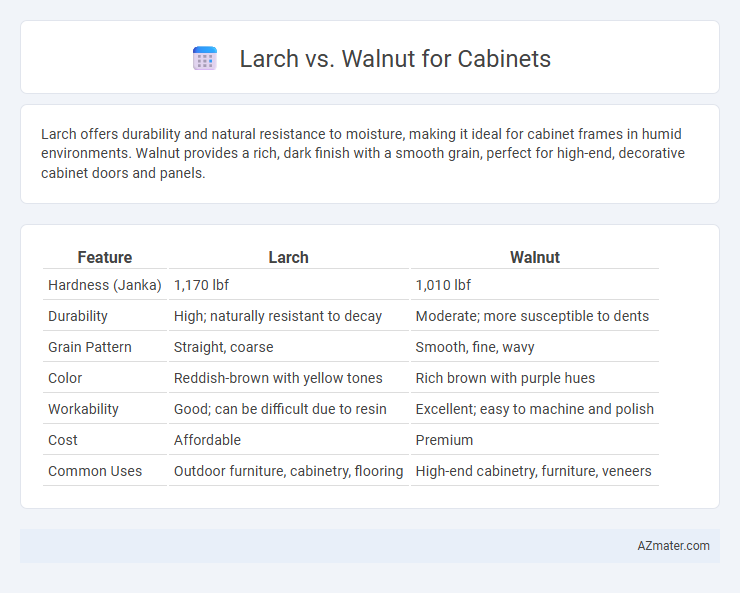Larch offers durability and natural resistance to moisture, making it ideal for cabinet frames in humid environments. Walnut provides a rich, dark finish with a smooth grain, perfect for high-end, decorative cabinet doors and panels.
Table of Comparison
| Feature | Larch | Walnut |
|---|---|---|
| Hardness (Janka) | 1,170 lbf | 1,010 lbf |
| Durability | High; naturally resistant to decay | Moderate; more susceptible to dents |
| Grain Pattern | Straight, coarse | Smooth, fine, wavy |
| Color | Reddish-brown with yellow tones | Rich brown with purple hues |
| Workability | Good; can be difficult due to resin | Excellent; easy to machine and polish |
| Cost | Affordable | Premium |
| Common Uses | Outdoor furniture, cabinetry, flooring | High-end cabinetry, furniture, veneers |
Introduction to Larch and Walnut Cabinets
Larch cabinets feature a distinctive grain pattern and natural resin content that provides exceptional durability and resistance to moisture, making them ideal for rustic or Scandinavian-style kitchens. Walnut cabinets are prized for their rich, dark hues and smooth texture, offering a luxurious aesthetic combined with fine workability and excellent structural stability. Both woods bring unique qualities to cabinetry, with larch emphasizing rugged longevity and walnut showcasing elegant sophistication.
Visual Appeal: Color, Grain, and Texture
Larch wood showcases a warm golden hue with prominent, straight grain patterns and a slightly rough texture that brings a rustic charm to cabinets. Walnut features a rich chocolate-brown color with intricate, swirling grain and a smooth, velvety texture that imparts a sophisticated, elegant look. The visual appeal of larch suits natural, cozy interiors, while walnut offers a luxurious finish ideal for formal or modern cabinet designs.
Durability and Hardness Comparison
Larch wood offers moderate durability with a Janka hardness rating of approximately 830, making it resistant to wear and suitable for cabinet construction in low to medium traffic areas. Walnut, with a higher Janka hardness rating of about 1010, provides greater hardness and superior resistance to dents and scratches, enhancing its durability for cabinetry subjected to frequent use. The denser structure of walnut also contributes to its longer lifespan and better performance under heavy wear compared to the softer and more resinous larch.
Workability and Ease of Installation
Larch wood offers excellent workability due to its relatively soft texture, making it easier to saw, plane, and shape for cabinet construction compared to walnut. Walnut, while harder and denser, provides a smooth finish but requires sharper tools and more effort during installation, which can increase labor time. Cabinets made from larch are generally lighter and simpler to handle, making the installation process faster, whereas walnut's durability often demands careful handling and precise fitting.
Cost Differences: Larch vs Walnut
Larch cabinets typically cost less than walnut due to the larch's abundant availability and faster growth rate, making it a budget-friendly option. Walnut, known for its rich color and luxurious grain, commands higher prices driven by its rarity and slower growth, impacting overall cabinetry cost. Choosing between larch and walnut hinges on balancing budget constraints with desired aesthetic and durability qualities.
Sustainability and Environmental Impact
Larch wood, known for its rapid growth and natural durability, offers a more sustainable option for cabinetry compared to walnut, which is slower growing and often harvested from older-growth forests. Walnut cabinets tend to have a higher environmental impact due to longer maturation periods and limited regional availability, leading to increased transportation emissions. Choosing larch supports more responsible forestry practices and reduces the carbon footprint associated with cabinet production.
Maintenance and Longevity
Larch wood offers excellent durability and natural resistance to decay, requiring minimal maintenance such as occasional sealing or oiling to preserve its appearance and longevity. Walnut, prized for its rich color and fine grain, demands more regular upkeep including polishing and moisture control to prevent warping and surface damage. Both woods provide long-lasting cabinetry, but larch's resilience makes it better suited for high-moisture environments, while walnut requires more careful climate management to maintain its premium finish.
Best Use Cases for Larch Cabinets
Larch cabinets are best suited for kitchens and bathrooms where moisture resistance is critical due to their natural durability and tight grain structure. Their warm, reddish hue enhances rustic, country, or contemporary design styles, making them ideal for creating cozy yet modern living spaces. Larch's lightweight nature also makes it a practical choice for wall-mounted cabinetry, offering both strength and aesthetic appeal.
Best Use Cases for Walnut Cabinets
Walnut cabinets excel in luxury kitchen designs and upscale living spaces due to their rich, dark tones and smooth grain pattern that add warmth and sophistication. Ideal for traditional and modern interiors, walnut offers excellent durability and resistance to warping, making it suitable for high-traffic areas like kitchens and dining rooms. Compared to larch, walnut's fine texture and elegant appearance make it the best choice for custom cabinetry requiring a premium aesthetic and long-term investment.
Final Verdict: Choosing the Right Wood for Cabinets
Larch offers exceptional durability and resistance to moisture, making it ideal for cabinets in humid environments, while walnut provides a rich, dark finish with natural grain patterns that elevate aesthetic appeal in high-end cabinetry. For projects prioritizing budget and functionality, larch's affordability and strength make it a practical choice, whereas walnut suits those emphasizing luxury and timeless elegance. Selecting between larch and walnut ultimately depends on balancing moisture resistance, cost considerations, and desired visual impact in cabinet design.

Infographic: Larch vs Walnut for Cabinet
 azmater.com
azmater.com